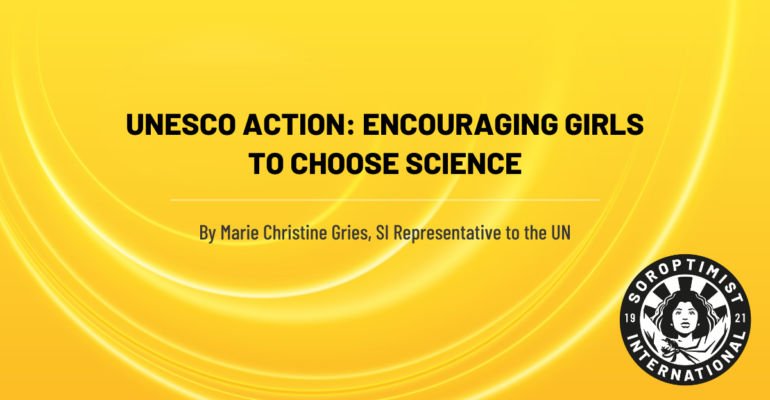Blog of Marie-Christine Gries, SI Representative to UNESCO in Paris.
A journalist once asked Marie Curie (before she won her personal Nobel Prize): ‘How does it feel to be married to a genius? The eminent researcher replied: ‘I don’t know, ask my husband’…
The proportion of women in scientific research is stagnating at around 30% worldwide.
In the wake of the L’Oréal prizes awarded to women researchers, UNESCO is launching an action campaign based on three essential pillars:
- Raising the profile of the role of women in science,
- The development of innovative educational strategies to encourage girls to choose science,
- The implementation of policies and actions to promote inclusion, diversity and equality in the working environment of the scientific sectors in order to retain the women who enter them.
UNESCO’s campaign calls for the active participation of women scientific researchers around the world, not forgetting the key partners for this action (business, education, supervisory authorities and family organisations).
Gathered in three brainstorming working groups corresponding to each pillar, the women researchers involved in this campaign are invited to share their personal experiences: their school and university education, their career path, their status in the workplace, and the management of their family life. They will be asked to draw lessons from their own experiences and together formulate proposals for innovative measures for the three pillars.
Group 1: Highlighting Inspiring Women Scientists
The first group was asked to nominate (by consensus) women in their environment whose career path would serve as inspirative model (scientific successes, but also obstacles encountered and overcome),
The expected results of visibility would be:
- General recognition of the skills of women scientists, whose work is all too often ignored or attributed to male colleagues (all the easier when they are in the minority in mixed teams).
- Stimulation of scientific vocations among girls, emulation thanks to the promotion of inspiring personalities, role models and even mentors for girls who are very often discouraged.
Discriminatory ‘ignorance’ is also an obstacle to a young girl’s family and school environment encouraging her to take up science. Ignorance leads to the belief that women only have access to technical assistance positions.
Group 2: Educational Reforms for Gender Equality in Science
The second group considered the measures needed in education and teacher training. These measures include recognising the equal abilities of girls and boys; dispelling discriminatory prejudices; designing school facilities to take account of girls’ needs; and eliminating the biases found in documentation, materials, and textbooks. They also emphasised giving teachers the arguments they need to encourage girls to choose science. Furthermore, they proposed establishing communication between families and teachers, particularly so that parents abandon their own prejudices, accept a future for their daughters that is different from their expectations, are reassured about their daughters’ abilities and the cost of studying, and are informed about the material assistance they can receive.
Group 3: Policy Changes for Inclusion and Diversity in Science
The third group was tasked with proposing policies and actions to promote equality, diversity, and inclusion in scientific fields. Their focus is on improving working conditions and the environment for women scientists, eliminating sexist barriers, and breaking the glass ceiling in scientific research companies and institutions.
The action, launched in mid-September, is expected to require several working sessions, with the aim of presenting initial conclusions at UNESCO’s General Conference in 2025.
Conclusion
UNESCO’s campaign marks a significant step toward fostering a more inclusive and supportive environment for women in science. By highlighting inspiring role models, reforming educational strategies, and addressing workplace inequalities, these working groups are paving the way for a new generation of female scientists. The collaboration between women researchers, educators, policymakers, and key partners is crucial for breaking down the barriers that have hindered progress. The initial findings and proposals from this initiative will contribute to shaping a more equitable future, with UNESCO’s General Conference in 2025 as a milestone for action.

